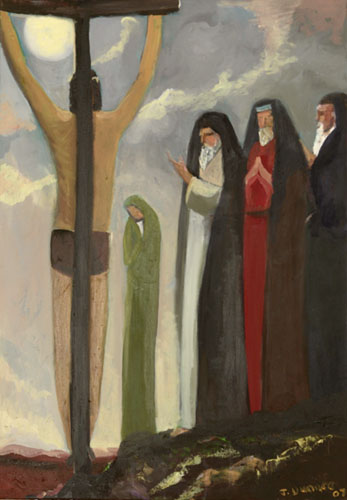Surely they are to blame! But before we take this line of thought we must remember that the Christian
churches have had to seek forgiveness from those accused and we must never
forget the dasterly crimes that stemmed from such a stance and viewpoint.
Reflecting now on the importance of such a figure, I can understand its significance as a spiritual vortex: a place within which we as the viewer can be drawn into the scene. For in fact this figure is the viewer. If this is the case then the words spoken from the cross are directed at us. Our position, our point of view has now shifted from that of the viewer and now focuses on the ones looked upon and spoken about. From this new point of view we are looking into the face of Christ. We must listen with a new ear to hear what the word of forgiveness means for us and not just those elders or the soldiers or the howling mob crying out for the blood of this innocent victim. It is important at the start of this series of meditations to be in the right place both spiritually and physically. This is not a place of repentance, of asking for forgiveness. No, this is the putting ourselves in the same place as those we have historically blamed for the death of Christ: of those who, as fallen people, did not know what they were doing. We will look about for a scapegoat, even blame ourselves, but the point is that before anybody can lay claim to this crime, the death of God no less, the words of forgiveness are spoken from the cross, “Father forgive them for they know not what they do.” Now we begin to understand the importance of our orientation, for when we look into that face of Jesus and understand the compassion as well as the pardon, we may well be encouraged ourselves to forgive! Even those who have not asked for our forgivness. Go
to > Next
page | Introduction
|
|
. | ||||
|
copyright © 2009 The Sword of the Spirit | email: living.bulwark@yahoo.com publishing address: Park Royal Business Centre, 9-17 Park Royal Road, Suite 108, London NW10 7LQ, United Kingdom |
. |
